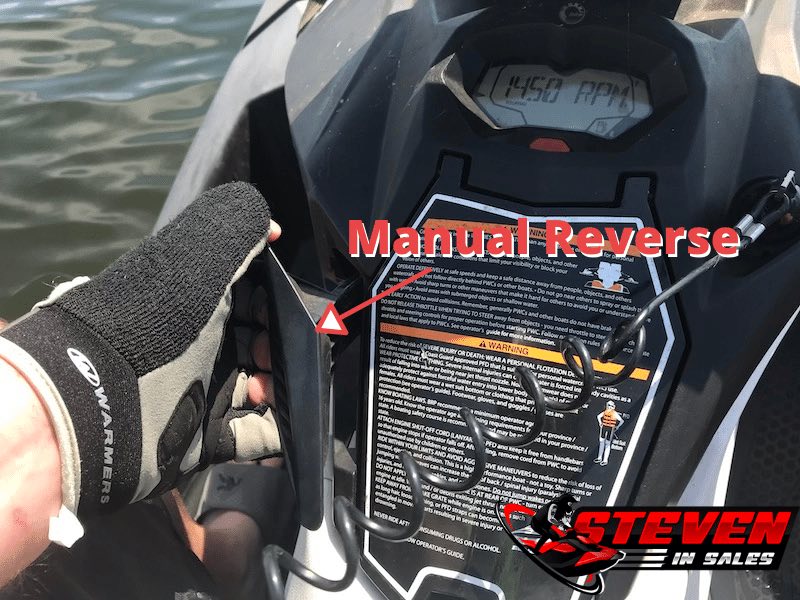Steering control or operation on a PWC that requires more than idle speed.
An idle speed is the speed at which a PWC travels without any input from the operator. A PWC moves at this speed when the engine is not running.
In general, idle speed will be between 2-4 mph depending on the make and model of the PWC. A PWC's idle speed affects its overall efficiency.
Increasing your idle speed will wear down your engine more rapidly, while reducing it will reduce noise and increase fuel economy. The PWC's idle speed also influences how well it maneuvers in tight spaces and around obstacles.
It is important to adjust idle speed according to the situation and the desired movement pattern. Most often, knots are measured in miles per
hour, but rpm (revolutions per minute) can also be used.

- With a jet drive, water is pumped into a pump and then forced out under pressure through a steering nozzle at the back of the unit. When the steering control is turned, the steering nozzle turns in the same direction as the "jet" of pressurized water. PWCs turn right when the steering control is turned right, causing the jet of water to push the back of the vessel to the left, causing it to turn right.
- Keeping control of most PWCs (and other jet-driven vessels) depends on having power at all times. During operation, if you let a PWC's engine idle or shut off, your steering control may be lost. When the throttle is released or the engine is shut off, many PWCs will continue in the direction they were heading.
- Stopping should always be allowed plenty of room. After releasing the throttle or shutting off the engine, you may not stop immediately. Even PWCs with brakes don't stop immediately. To avoid being thrown from a PWC, never use reverse (if equipped).
- Despite its maneuverability, PWCs can get into trouble very quickly. The following are some important things to remember when operating a PWC.
- Keep a safe distance from other PWCs. A sharp turn or stalling could cause you to collide with the bike; a fall could result in the other rider being run over.
- When making turns, look behind you over both shoulders; another boat may be too close behind you.
- Keep an eye on all traffic in your boating area; don't just focus on the short distance in front of you.
- It is important to remember that operating a PWC is the same as operating any other motorboat.
- Here are some of the safe PWC practices.
Frequently Asked Questions
- When steering a PWC, what is the most important thing to remember?
When steering a PWC, keep your hands on the handlebars at all times. A PWC will lose control if you release the handlebars.
- Which steering system is right for my PWC?
You should consult a professional to determine which steering system is best for your PWC. Based on your specific needs, they will help you select the best steering system for your PWC.
- The steering system of a PWC consists of what main component?
A PWC's steering system is mainly composed of handlebars. Controlling the direction of the PWC is done with the handlebars.
- How do different steering systems differ in terms of benefits and drawbacks?
Handlebar steering systems are easy to use and provide good control over the PWC. Handlebar steering systems can be difficult to steer in tight spaces and can be uncomfortable for long periods of time.
In addition to being easier to steer in tight spaces, jet ski steering systems can be more comfortable for long periods of time. There are some drawbacks to jet ski steering systems, including the fact that they are difficult to use and do not provide as much control as a boat.
- Which steering control is best for a PWC?
An ideal steering control for a PWC is a handlebar steering system. Controlling the PWC is easy with this system.
- When a PWC loses its steering ability, what can cause it?
The PWC will lose control if you let go of the handlebars.
- What is the best way to drive a boat in high waves?
If you are driving a boat in high waves, keep it pointed into the waves. Capsizing can be prevented by stabilizing the boat.
- Can you tell me how to operate a PWC?
PWCs require a valid boating license to operate. You must also be at least 18 years old. It is necessary to push the start button in order to start the PWC. Using the throttle, you can control the speed of the PWC once it is running.
- Right-hand steering controls on PWCs cause what?
PWCs turn right when their steering controls are turned to the right.
- How are jet skis and PWCs different?
It is a type of PWC that is designed for racing. Typically, PWCs are used for recreational purposes.
- How can a PWC operator minimize the risk of injury or accident?
Operators of PWCs should always wear life jackets. Using the PWC in crowded areas is also not recommended.
- Before letting someone else operate your PWC, what should you do?
Give someone a safety briefing before they operate your PWC. Instructions should include how to start the PWC, how to operate the throttle, and how to turn it.

- Why should you own a PWC?
Among the benefits of owning a PWC are the fact that they are fun to ride and can be used for recreation.
- Summary
- PWCs are ultimately controlled by the rider. Leaning and shifting their weight allows them to control the direction of the PWC. Once you get used to steering a PWC with your body, it is actually quite easy once you get the hang of it.
- ۰ ۰
- ۰ نظر